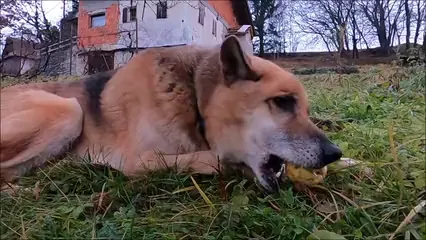Introduction
As pet owners, we often find ourselves wanting to share our favorite snacks with our furry friends. Pineapple, with its tropical charm and sweet, tangy flavor, might seem like a delightful treat for dogs. But before tossing a piece to your pup, you may wonder: Is pineapple safe for dogs? In this article, we’ll explore the nutritional benefits, potential risks, and the best ways to serve pineapple to your canine companions. Spoiler alert: your dog might just enjoy this fruity delight!
Speaking of fruit, if you want to make your pineapple preparation a breeze, consider investing in a Pineapple Slicer. This nifty gadget will have you slicing up that juicy goodness in no time, so you can focus on treating your pup!
Summary
In this article, we’ll examine the question of whether dogs can eat pineapple, examining the fruit’s nutritional benefits, potential risks, and how to safely introduce it into your dog’s diet. We’ll discuss proper serving sizes based on your dog’s breed and size, the best forms of pineapple to offer, and the importance of moderation. Additionally, we’ll explore common questions regarding pineapple consumption, such as its effects on coprophagia (poop-eating) behavior. By the end, you’ll be equipped with all the knowledge needed to determine if this tropical treat is a suitable addition to your dog’s diet.
And while you’re at it, why not treat your furry friend to some tasty Dog Treats Variety Pack? Because who doesn’t enjoy a good snack while you’re munching on pineapple?
Nutritional Benefits of Pineapple for Dogs
Overview of Nutrients
Pineapple is a treasure trove of nutrients. It boasts an impressive lineup of vitamins and minerals. Notably, it contains Vitamin C, which can boost your dog’s immune system. Vitamin B6 supports energy levels and metabolism. Manganese and potassium help maintain healthy bodily functions too. These nutrients can contribute to a dog’s overall health and vitality.

Pineapple also packs a hydrating punch. With over 80% water content, it’s like a refreshing drink on a hot day. Plus, the fiber in pineapple can aid digestion, keeping things running smoothly in your pup’s tummy. Just remember, too much of a good thing can lead to tummy troubles.
And if you’re looking for a way to keep your dog healthy, consider adding Organic Dog Food to their diet. It’s a great way to ensure they get the best nutrition possible!
Bromelain and Its Benefits
Now, let’s talk about bromelain. This impressive enzyme is found in pineapple and has some remarkable properties. It’s known for its anti-inflammatory effects. That means it might help your dog with sprains or other minor injuries. Bromelain can also assist in breaking down proteins, making digestion easier for your furry friend.
While bromelain is a superstar, moderation remains essential. Overindulgence in pineapple could lead to digestive upset. So, keep the pineapple servings small and watch your pup enjoy this delightful fruit responsibly.
Risks of Feeding Pineapple to Dogs
High Sugar Content
While pineapple is a nutritious treat, it does come with a sweet side—natural sugars! Yes, pineapple is delicious, but those sugars can be a double-edged sword. They can lead to weight gain, obesity, or even diabetes in our furry friends if consumed in excess. For more information on managing canine diabetes, you can check out this resource on understanding and managing canine diabetes.

And while you’re monitoring your dog’s health, consider a Pet First Aid Kit. Because accidents happen, and it’s always better to be prepared!
It’s crucial to understand the risks associated with high sugar content in fruits like pineapple, especially concerning conditions like diabetes. Understanding and managing canine diabetes can help you make informed decisions for your pet’s health.
For the sake of your pup’s health, it’s important to keep portion sizes in check. As a rule of thumb, treats should only make up about 10% of your dog’s daily calorie intake. For example, a small dog might only need a couple of pineapple chunks, while a larger breed can handle a handful.
Always monitor your dog’s response to pineapple. If you notice any signs of gastrointestinal upset, like diarrhea or vomiting, it’s time to cut back and consult your vet.
In summary, while pineapple can be a delightful addition to your dog’s diet, be mindful of its sugar content. Keeping portions small and serving it occasionally ensures your pup can enjoy pineapple without any of the sugary drawbacks.
Choking Hazards and Digestive Issues
When it comes to sharing pineapple with your furry friend, not all parts of the fruit are created equal. The skin and core of the pineapple are off-limits! The skin is tough and prickly, making it a choking hazard. Meanwhile, the core is hard and fibrous, posing a risk for intestinal blockage. If your pup tries to chew on these parts, it could lead to serious digestive issues.

If your dog indulges in too much pineapple, you may notice some not-so-pleasant symptoms. Overconsumption can lead to vomiting or diarrhea. Just like us, dogs can have sensitive tummies, and pineapple’s natural sugars and fiber might upset their stomachs. So, moderation is key! Stick to small, manageable portions to keep those digestive troubles at bay.
Allergic Reactions
While pineapple is generally safe for dogs, allergic reactions can still happen. Some pups may experience sensitivities when trying new foods. It’s essential to keep an eye on your dog after introducing pineapple into their diet. Watch for any signs of an allergic reaction, such as itching, swelling, or gastrointestinal upset. If you notice any of these symptoms, it might be time to consult your vet. Better safe than sorry, right? Always proceed with caution when feeding your dog new treats!
How to Safely Feed Pineapple to Your Dog
Preparing Pineapple
Feeding pineapple to your dog can be a delightful experience if done correctly. Follow these steps to prepare fresh pineapple safely:
- Choose a Ripe Pineapple: Look for a pineapple that is firm yet slightly soft when pressed. The leaves should be green and fresh, indicating ripeness.
- Wash Thoroughly: Rinse the pineapple under cool water to remove any dirt or pesticides.
- Remove the Crown: Cut off the leafy top, also known as the crown, as this part is inedible.
- Slice Off the Skin: Carefully slice away the spiky, tough skin. Make sure to remove all the prickly eyes too, as they can be harmful to your dog.
- Cut Out the Core: The core is too hard for dogs to digest, so cut it out and discard it.
- Chop into Small Pieces: Slice the remaining fleshy part into bite-sized chunks. Aim for pieces that are easy for your dog to chew and swallow.
- Serve Fresh: Offer the freshly cut pineapple to your dog as a tasty treat! Remember to start with a small amount to gauge their reaction.

With these steps, your pup can enjoy a refreshing snack without any risks. Pineapple can be a fun addition to their diet, just be sure to keep it safe and sound!
And if you want to keep your dog feeling comfortable while enjoying their fruity treats, check out a Dog Bed. After all, every dog deserves a cozy spot to relax!
Serving Suggestions
Pineapple is not just delicious; it’s versatile too! Here are some fun ways to serve it to your furry friend.
- Fresh: Fresh pineapple is the way to go. Start by cutting the juicy flesh into bite-sized chunks. This makes it easy for your pup to enjoy without the worry of choking.
- Frozen: Hot day? No problem! Freeze small chunks of pineapple for a refreshing treat. It’s like a popsicle, but for dogs! Just make sure the pieces are small enough to avoid any risks.
- Blended: Want to get fancy? Blend pineapple with other dog-safe fruits like bananas or blueberries. You can create delightful smoothies or pour the mixture into ice cube trays for a cool snack.
- Pineapple Smoothies: For a nutritious twist, combine pineapple with plain yogurt and some spinach. Blend and freeze it in a KONG toy for a fun, interactive treat!
- Frozen Treats: Puree pineapple and freeze it in fun shapes. Your dog will love the cold, fruity goodness on a warm day!

Keep it fresh, keep it fun, and your dog will be wagging its tail in delight!
Frequency and Portion Control
Feeding pineapple to your dog can be a tasty treat, but moderation is essential. Remember the 10% rule! Treats should only make up 10% of your dog’s daily calorie intake.
For small dogs, a few chunks may suffice. Larger breeds can enjoy a handful. If your dog is experiencing any digestive issues after pineapple, reduce the amount or frequency. Always introduce any new treat gradually to monitor for any adverse reactions.
By keeping serving sizes in check, your pup can enjoy pineapple without any tummy troubles while still feeling special!
Common Questions About Dogs and Pineapple
Can Puppies Eat Pineapple?
Yes, puppies can enjoy pineapple! However, introduce it slowly. Start with tiny pieces to ensure it doesn’t upset their delicate tummies. Since puppies are still developing, be cautious with new foods. Always consult your vet before adding pineapple to their diet, especially if they have sensitive stomachs.
Can Dogs Have Canned or Dried Pineapple?
Canned pineapple? Not so much! It often comes in syrup, which is loaded with sugar and can lead to health issues. Dried pineapple is also a no-go due to its concentrated sugar content. Fresh pineapple is the best option.
Stick to the juicy, fleshy part of the pineapple, and avoid the skin and core. They can pose choking hazards and are hard for dogs to digest. Always prioritize fresh, raw pineapple to keep your pup happy and healthy!
Can Pineapple Stop Dogs from Eating Poop?
Ah, coprophagia—the fancy term for a behavior that leaves many dog owners scratching their heads. Some folks claim that feeding pineapple to dogs can deter them from this less-than-pleasant habit. The theory? Pineapple contains bromelain, an enzyme that may alter the taste of feces, making it unappetizing to our furry friends.
However, let’s pump the brakes a bit. While there are numerous anecdotal claims floating around, scientific evidence is surprisingly scarce. Many vets agree that there’s no solid proof that pineapple effectively curbs poop-eating behavior. So, while it might be worth a try if your pup has a penchant for snacking on their own business, don’t bank on pineapple as a magical solution! If your dog’s coprophagia persists, consulting a veterinarian is the best course of action.
Other Human Foods Safe for Dogs
While pineapple is a fun and fruity option, it’s not the only human food that can make your dog’s tail wag! There are plenty of safe fruits and veggies to consider.
- Apples are a great source of vitamins A and C. Just remember to remove the seeds!
- Carrots are crunchy and low-calorie, making them a perfect snack.
- Blueberries are antioxidant powerhouses that many dogs love.
- And don’t forget green beans—they’re high in fiber and low in calories, too!

These dog-friendly foods can add variety to your pup’s diet while providing essential nutrients. Just like with pineapple, moderation is key. Always introduce new foods gradually and consult your vet if you have any concerns. Your furry friend will appreciate the culinary exploration!
Speaking of variety, if you’re looking for something to keep your dog entertained, consider a Dog Puzzle Toy. It’s a great way to stimulate their mind while you whip up some pineapple treats!
Conclusion
In conclusion, pineapple can be a delightful and nutritious treat for dogs when offered in moderation and prepared correctly. While it’s packed with beneficial nutrients, it’s essential to be mindful of serving sizes and potential risks. Pineapple contains natural sugars, which can lead to weight gain or digestive issues if consumed excessively. Always consult your veterinarian if you have concerns about your dog’s diet or health conditions. So, the next time you enjoy a slice of pineapple, don’t hesitate to share a little with your furry friend—just remember, moderation is key!

If you’re planning a trip with your pup, don’t forget to grab a Dog Travel Carrier for safe travels. Your dog will thank you for the comfy ride!
FAQs
Can dogs eat pineapple juice?
Pineapple juice can be given to dogs, but only in moderation. Always opt for fresh-squeezed juice without added sugars. A tablespoon or two should suffice as a treat!
Is pineapple toxic to dogs?
No, pineapple is not toxic to dogs. However, it should be fed carefully and in small amounts due to its sugar content.
How much pineapple can I give my dog?
Serving sizes depend on your dog’s weight. As a rule of thumb, small dogs can have 1-2 chunks, while larger breeds can enjoy a handful.
What should I do if my dog eats too much pineapple?
If your dog overeats pineapple, monitor for symptoms like vomiting or diarrhea. If these occur, contact your veterinarian for advice.
Can dogs eat the pineapple crown or leaves?
No, the crown and leaves of the pineapple are not safe for dogs. Stick to the fleshy part of the fruit only.
Please let us know what you think about our content by leaving a comment down below!
Thank you for reading till here 🙂
All images from Pexels





